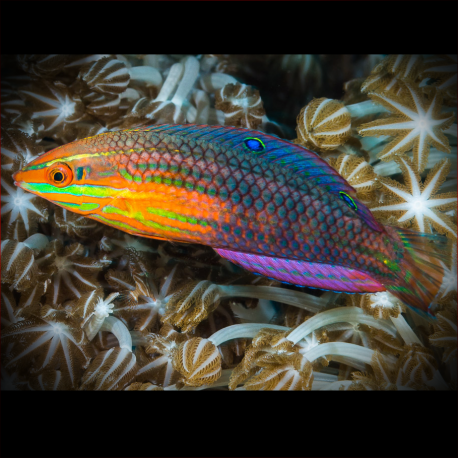More info
Datasheet
| Minimum Tank Size | 189 litres / 49.93 US gallons |
| Maximum Size | 10.2cm / 4.02inches |
| Reef Compatible | Yes |
| Temperament | Peaceful |
| Care Description | Easy |
| Specific Gravity | 1.020-1.025 |
| Carbonate Hardness | 8-12 |
| pH | 8.1-8.4 |
General Description
The Red-Lined Wrasse, scientifically known as Halichoeres biocellatus, is a visually striking fish with bold stripes, showcasing distinctive false eyes on its dorsal fin in its juveniles and sub-adult stages, which fade as it matures. Belonging to the Labridae family, this carnivorous species boasts a maximum size of approximately 10.2cm and a peaceful temperament.
Aquarium Suitability
With its peaceful nature and compatibility with reef environments, the Red-Lined Wrasse is well-suited for display in a reef aquarium. Its tank requirements include a minimum size of 189 liters (50 gallons) and a secure lid to prevent escapes due to their active nature.
Demands, Care, and Hardiness
Considered an easy species to care for, the Red-Lined Wrasse thrives in water conditions with a pH range of 8.1-8.4, a specific gravity of 1.020-1.025, and a carbonate hardness (KH) of 8-12.
Reef Suitability
Reef compatibility is a notable trait of the Red-Lined Wrasse, as it tends not to harm sessile invertebrates like soft and stony corals. However, caution should be exercised as it may consume desirable ornamental invertebrates such as fan worms and shrimp.
Aquarium Setup
To recreate the natural habitat of the Red-Lined Wrasse, a well-established saltwater aquarium with ample live rock and open sand substrate (2-3 inches deep) is recommended. Providing open swimming spaces mimicking reef crests and slopes ensures the fish's comfort. It is advisable to house them with other peaceful wrasses, preferably of their species.
Behaviour
Known for its active foraging behavior, the Red-Lined Wrasse requires frequent small feedings throughout the day. This species plays a beneficial role in controlling populations of fireworms, pyramidellid snails, and parasites among tank mates.
Feeding and Diet
In captivity, the Red-Lined Wrasse should be fed a diet comprising vitamin-enriched frozen mysis shrimp and brine shrimp. While they primarily consume benthic invertebrates, it's important to note their indiscriminate feeding habits in an aquarium setting.
Dimorphism and Captive Reproduction
As the Red-Lined Wrasse matures, the false eyes present in juveniles and sub-adults disappear, making way for the distinctive bold stripes to become more prominent. Information on captive reproduction of this species is currently not covered.
Habitat and Distribution
The Red-Lined Wrasse, originating from seaward reefs, inhabits regions with rich live rock and sandy substrate. Its natural habitat typically includes reef crests and slopes within tropical marine environments.

